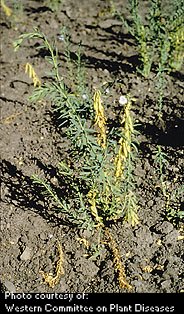Fusarium Wilt In Flax
This fungal disease invades flax through the roots, killing seedlings and older plants.

Host Crops
Flax
Biology
This disease is caused by a seed-borne and soil-borne fungus that invades plants through the roots, and continues growth inside the water-conducting tissue. The fungus interferes with water uptake. Warm weather favours the disease. The fungus persists in the soil, while the mycelia and spores survive for many years in flax debris and other organic tissue. Spores dispersed by wind and rain spread the fungus from one field to another.
Symptoms Of Damage
Seedlings may be killed shortly after emergence. Delayed infections cause yellowing and wilting of leaves, followed by browning and death of the plant. The roots of dead plants appear ash-grey. The tops of wilted plants often turn downward, forming a "shepherd's crook". Affected plants are usually scattered in patches throughout the field.
Scouting Techniques
Look for patches of wilted or prematurely dead plants exhibiting the "shepherd's crook".
Economic Thresholds
None available.
Control Tips
The most important control method is the use of available moderately-resistant varieties. Crop rotation of at least 3 years between flax crops helps to maintain low levels of inoculum in the soil.
For further information, contact your GO representative.
